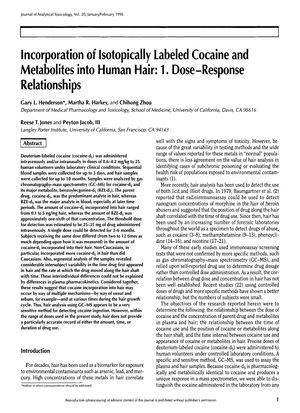Incorporation of Isotopically Labeled Cocaine and Metabolites into Human Hair: Dose-Response Relationships
January 1996
in “
Journal of analytical toxicology.
”

TLDR Hair analysis can detect cocaine use but doesn't accurately show the amount or timing of use.
Deuterium-labeled cocaine (cocaine-d5) was administered to 25 human volunteers in doses of 0.6–4.2 mg/kg, and samples were analyzed using GC-MS. Cocaine-d5 was the predominant analyte in hair, while benzoylecgonine-d5 (BZE-d5) was more prevalent in blood. The amount of cocaine-d5 in hair ranged from 0.1 to 5 ng/mg, with a detection threshold of 25–35 mg administered intravenously. Detection in hair lasted 2–6 months, but there was significant variability among subjects, with non-Caucasians incorporating more cocaine-d5 than Caucasians. The study suggested multiple mechanisms for cocaine incorporation into hair, such as sweat and sebum, and highlighted that hair analysis, while sensitive, did not accurately reflect the amount, time, or duration of drug use.